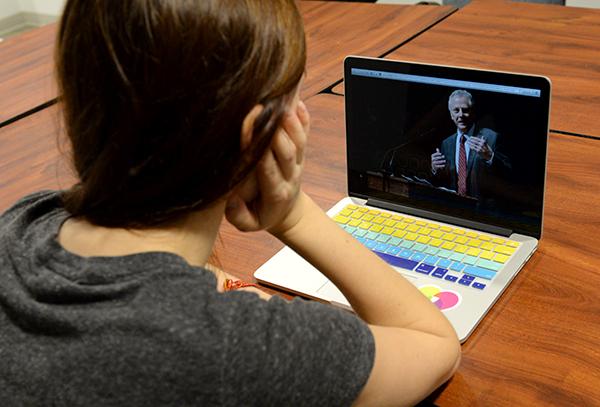GW is hoping a new in-house course design shop will prompt more departments to create online degree programs, which would help offset a $10 million budget gap caused by declining enrollment.
That would streamline the often complex and lengthy process of putting a semester-long class in an online format, which could then translate into the roll-out of more online programs. Those programs would serve as an extra stream of revenue for the University, which has had to tighten budgets in nearly every department this year.
Paul Schiff Berman, the vice provost for online learning and academic innovation, said he worked over the summer with Provost Steven Lerman to create the eDesign shop, which will allow professors to put their courses online while incorporating video, animation and graphics. It lets professors create courses without help from an outside consulting group, like 2U or Pearson, which other GW online programs have used.
“Schools are free to use outside partners to create online programs if they choose to do so, but the resources we can now provide internally offer a high-quality, customizable, and flexible alternative to such outsourcing,” Berman said in an email.
Berman is guiding faculty in creating five new online degree programs this year, and some have started using the in-house support. Those new programs – in health care administration, police safety and security, information systems and security studies, cybersecurity, organizational leadership, and the law and business of federal contracting – could launch within the next year.
They will likely attract a different type of graduate student – one who works during the day and can’t enroll full time on campus.
As GW looks to increase its number of online courses, Berman said a committee comprised of faculty from all schools that met last year urged his office to make it easier for faculty to create both hybrid and fully online programs.
“The committee recommended that, while the schools and departments should always have autonomy with regard to course content, my office should help the schools by taking on various administrative and coordination functions that are difficult or onerous for schools to handle individually,” he said.
He declined to sit for an interview to discuss his strategy for increasing the University’s enrollment through online education.
GW is hoping new online programs will offset a decrease in the number of students looking to enroll in graduate school, which comes as the job market rebounds.
The School of Nursing and the Milken Institute School of Public Health have successfully enrolled enough students to avoid the otherwise campus-wide drop in graduate enrollment. Enrolling online students – who still pay full tuition – helped those schools escape large budget cuts this fall.
Online programs have been a popular idea for the University’s signature financial program, the Innovation Task Force, which aims to find $60 million in new revenue or savings by next fiscal year. The University has launched new online programs for veterans, high school students and business administration masters programs through the ITF.
Some of the savings could be large: GW hoped to count on $3.3 million from an online program with reduced tuition for veterans and military families that included engineering and management courses. Officials also hoped to bring in an additional $12 million from online programs for high school and graduate students, as well as veterans and active military personnel.
Faculty creating the new programs are seeking out ways to engage new audiences, which could expand their departments’ pool of students. Because GW relies on tuition for most of its operating expenses, new programs with large numbers of students pour money into schools’ budgets.
And because online students aren’t on campus but pay full tuition, they don’t take up space in campus housing, which helps keep GW under its city-mandated enrollment cap.
Frederic Lemieux, director of the police science and security, and safety leadership programs, said his department is partnering with a community college to match graduates who are interested in the field with the new online police program. In its first semester, he hopes to enroll about 12 students, and eventually recruit around 25.
Lemieux said he won’t advertise the program in the D.C. area so that nearby students enroll in the on-campus program while the online program draws in students who live further away.
“We don’t want to compete with ourselves,” he said. “With technology now, we can really target the audience we’re looking for.”
The GW Law School and School of Business are also planning to relaunch a master’s of science in government contracting as an online program, after the two schools started the on-campus program last year. If the law school’s faculty vote to move forward with the program next semester, it will make GW one of the first top law schools in the country to enter the realm of online learning.
Law professors are piloting the school’s first online class this semester and preparing to move others online, said Neal Couture, the program’s director. Other top-ranked law schools, like New York University and Washington University in St. Louis, have started offering online master’s of law programs, which Couture said has given GW more confidence in putting their program online.
“It’s just like any other kind of change. When you’re not comfortable with it, change is uncomfortable because you’re dealing with a lot of unknowns,” Couture said. “It’s an opportunistic time to try things out.”
GW’s new online programs are focused on areas that are popular and in demand, said Farhad Saba, a professor emeritus of educational technology at San Diego State University.
As the profile of the traditional student changes, more universities are expanding their online offerings to provide more options for working professionals and potential students with family responsibilities, Saba said.
“I’m not surprised a lot of institutions are looking for those programs,” he said. “They’re areas that have become more important recently, as compared to traditional programs like an MBA.”








